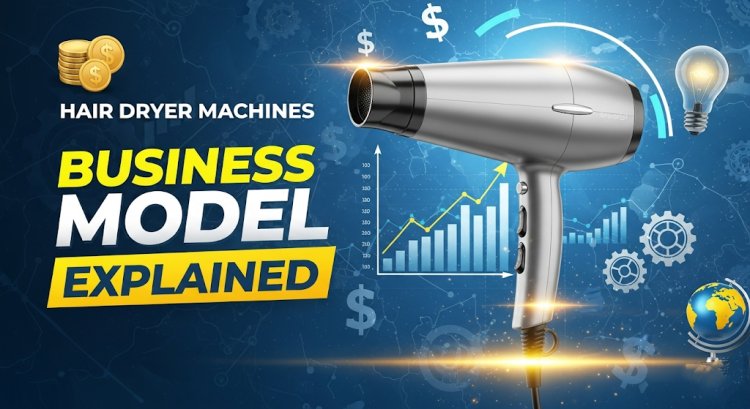Hair Dryer Machines Business Model:
Explore the complete business model of the hair dryer and beauty appliance industry. Learn about market trends, customer segments, revenue streams, innovation, challenges, and future growth opportunities for entrepreneurs and investors.

A Comprehensive Guide to Success in the Beauty Appliance Industry
Introduction
The hair dryer machine business model represents a dynamic sector within the global beauty and personal care industry, encompassing the design, manufacturing, marketing, and distribution of hair drying appliances. This business model has evolved from simple blow-drying devices to sophisticated, technology-driven products that cater to diverse consumer needs and professional requirements.
In today's competitive beauty landscape, understanding the hair dryer business model is crucial for entrepreneurs, investors, and industry professionals. The industry has witnessed remarkable transformation with the integration of advanced technologies, sustainable materials, and consumer-centric design approaches. From traditional coil-heated dryers to modern ionic and ceramic-infused models, the business model continues to adapt to changing consumer preferences and technological innovations.
The significance of this business model extends beyond mere product manufacturing—it encompasses strategic partnerships, innovative marketing approaches, and the ability to anticipate and respond to evolving beauty trends. As consumers become increasingly conscious about hair health, energy efficiency, and product durability, businesses operating in this space must develop comprehensive strategies that address these concerns while maintaining profitability and market competitiveness.
Market Overview
The global hair dryer industry represents a substantial and growing market segment within the broader personal care appliances sector. Current market analysis indicates that the industry is valued at approximately $8-10 billion globally, with projections suggesting continued growth driven by rising disposable incomes, urbanization, and increasing awareness about personal grooming.
Market Size and Growth Trends
The hair dryer market has demonstrated consistent growth over the past decade, with annual growth rates averaging 5-7% in most regions. North America and Europe continue to dominate market share, accounting for nearly 60% of global revenue, while Asia-Pacific markets, particularly China and India, show the highest growth potential due to expanding middle-class populations and changing lifestyle patterns.
Professional-grade hair dryers constitute approximately 30% of the total market value, despite representing a smaller volume of units sold. This segment commands premium pricing due to advanced features, superior build quality, and longer warranty periods. The consumer market, while price-sensitive, drives volume sales and provides opportunities for brands to establish market presence and build customer loyalty.
Regional Market Analysis
Different geographical markets exhibit unique characteristics and growth drivers. The North American market emphasizes energy efficiency and smart features, driven by environmental consciousness and technology adoption. European markets prioritize durability and design aesthetics, while Asian markets show strong demand for multifunctional devices and compact designs suitable for smaller living spaces.
Emerging markets in Latin America and Africa present significant untapped potential, with growing urban populations and increasing beauty consciousness creating new opportunities for market expansion.
Target Audience & Customer Segments
The hair dryer business model serves diverse customer segments, each with distinct needs, preferences, and purchasing behaviors. Understanding these segments is essential for developing targeted products and marketing strategies.
Professional Salon Segment
Professional salons represent the most lucrative customer segment, typically purchasing high-performance dryers priced between $200-800 per unit. This segment values durability, consistent performance, ergonomic design, and manufacturer support services. Professional customers often establish long-term relationships with suppliers and are willing to pay premium prices for products that enhance their service quality and operational efficiency.
Salons typically replace equipment every 2-3 years and often purchase multiple units simultaneously, making them valuable customers for bulk sales and ongoing service contracts.
Consumer Household Market
The household segment forms the largest volume market, with price points ranging from $30-300 depending on features and brand positioning. This segment can be further subdivided into:
- Budget-conscious consumers: Seeking basic functionality at affordable prices
- Mid-market consumers: Balancing features and price, typically spending $80-150
- Premium consumers: Willing to invest in high-end features and brand prestige
Hospitality Industry
Hotels, resorts, and hospitality chains represent a growing B2B segment that requires reliable, cost-effective hair dryers for guest rooms. This segment typically prioritizes durability, safety features, and vandal-resistant designs over advanced styling features.
Travel and Portable Market
Frequent travelers and professionals who travel for work constitute a niche but profitable segment for compact, dual-voltage hair dryers. This segment values portability, versatility, and international compatibility.
Value Proposition
Success in the hair dryer business model depends on delivering clear value propositions that resonate with target customer segments. Leading companies differentiate themselves through several key value drivers.
Innovation and Technology Integration
Modern hair dryer businesses invest heavily in technological innovations that improve performance and user experience. Ionic technology reduces frizz and drying time, ceramic heating elements provide even heat distribution, and tourmaline coatings add shine and reduce damage. Advanced models now incorporate smart sensors that adjust temperature and airflow based on hair type and moisture levels.
Design and Ergonomics
Professional-grade and premium consumer dryers emphasize ergonomic design to reduce user fatigue during extended use. Lightweight materials, balanced weight distribution, and intuitive controls contribute to superior user experience and justify premium pricing.
Energy Efficiency and Sustainability
With growing environmental consciousness, energy-efficient models that reduce power consumption without compromising performance represent significant value propositions. Some manufacturers now offer eco-friendly options using recycled materials and sustainable manufacturing processes.
Durability and Reliability
Commercial and professional segments particularly value durability, with some models designed for continuous operation and extended lifespans. Comprehensive warranty programs and reliable customer service support these value propositions.
Smart Features and Connectivity
Emerging smart hair dryers offer app connectivity, personalized heat settings, usage tracking, and maintenance reminders. These features appeal to tech-savvy consumers and justify premium pricing in competitive markets.
Revenue Streams
The hair dryer business model incorporates multiple revenue streams that contribute to overall profitability and business sustainability.
Direct-to-Consumer Sales
Online and retail direct sales typically offer the highest profit margins, allowing companies to maintain control over pricing, customer experience, and brand presentation. E-commerce platforms have become increasingly important, particularly following COVID-19-related shopping behavior changes.
Wholesale and Retail Partnerships
Traditional retail partnerships with department stores, beauty supply retailers, and electronics stores provide volume sales opportunities and market exposure. While margins are typically lower, these partnerships offer market reach and credibility that support brand building efforts.
Professional and B2B Sales
Sales to salons, spas, and other professional establishments often involve higher-value transactions and longer-term relationships. This segment may include service contracts, training programs, and ongoing support services that generate recurring revenue.
International Distribution
Export sales to international markets can provide significant revenue growth opportunities, though they require careful consideration of different market regulations, consumer preferences, and distribution challenges.
Accessories and Consumables
Additional revenue streams include specialized attachments, replacement parts, cleaning products, and maintenance kits that provide ongoing customer value and recurring income.
Private Label Manufacturing
Some companies generate revenue by manufacturing hair dryers for other brands, leveraging their manufacturing capabilities and expertise while reducing marketing and distribution costs.
Cost Structure
Understanding the cost structure is essential for maintaining profitability and competitive pricing in the hair dryer business model.
Manufacturing and Production Costs
Raw materials typically account for 40-50% of total production costs, including motors, heating elements, plastics, electronic components, and housing materials. Labor costs vary significantly by manufacturing location, with many companies utilizing overseas production to maintain competitive cost structures.
Research and Development
Successful hair dryer companies invest 5-10% of revenue in R&D activities, focusing on technology improvements, new product development, and manufacturing process optimization. This investment is crucial for maintaining competitive advantage and responding to evolving consumer needs.
Marketing and Advertising
Marketing costs typically range from 10-20% of revenue, depending on brand positioning and market competition. Professional brands may rely more heavily on trade shows and industry relationships, while consumer brands invest significantly in digital marketing, influencer partnerships, and traditional advertising.
Distribution and Logistics
Distribution costs include warehousing, shipping, and inventory management, typically accounting for 8-12% of revenue. International distribution can significantly increase these costs due to customs, compliance requirements, and longer supply chains.
Administrative and Overhead
General administrative costs, including staff salaries, facilities, insurance, and regulatory compliance, typically account for 10-15% of revenue, varying based on company size and operational complexity.
Key Partners & Distribution Channels
Strategic partnerships are essential components of successful hair dryer business models, providing market access, operational efficiency, and competitive advantages.
Manufacturing Partners
Many brands partner with specialized manufacturers, particularly in regions with cost advantages and technical expertise. These partnerships allow companies to focus on design, marketing, and brand building while leveraging manufacturing expertise and economies of scale.
Retail Partnerships
Relationships with major retailers like Target, Walmart, Sephora, and Ulta Beauty provide essential market access and credibility. These partnerships often involve collaborative marketing efforts, exclusive product variants, and strategic shelf placement.
Professional Channel Partners
Distributor relationships with salon and beauty supply companies provide access to professional markets and ongoing service opportunities. These partners often provide training, technical support, and marketing assistance to end customers.
Technology Partners
Partnerships with technology companies enable integration of smart features, app development, and connectivity capabilities that differentiate products in competitive markets.
Supply Chain Partners
Relationships with component suppliers, logistics providers, and quality assurance organizations ensure consistent product quality and reliable delivery performance.
Marketing & Branding Strategy
Effective marketing and branding strategies are crucial for success in the competitive hair dryer market, requiring different approaches for various customer segments.
Brand Positioning and Differentiation
Successful hair dryer brands establish clear positioning that resonates with target customers. Professional brands emphasize performance, reliability, and industry expertise, while consumer brands may focus on convenience, style, or value. Luxury brands highlight premium materials, advanced technology, and exclusive design.
Digital Marketing and Social Media
Modern hair dryer marketing relies heavily on digital channels, particularly social media platforms where beauty influencers demonstrate products and share tutorials. Instagram, YouTube, and TikTok have become essential platforms for reaching younger demographics and building brand awareness.
Influencer Partnerships
Collaborations with hair stylists, beauty influencers, and celebrities provide authentic product endorsements and demonstrate real-world applications. These partnerships often generate significant social media engagement and drive purchase decisions.
Content Marketing
Educational content about hair care, styling techniques, and product benefits helps establish brand authority and provides value to potential customers. This approach is particularly effective for building long-term customer relationships and supporting premium pricing strategies.
Trade Shows and Professional Events
Participation in beauty industry trade shows and professional events provides opportunities to demonstrate products, build relationships with distributors and salon owners, and gather market intelligence about competitor activities and emerging trends.
Challenges & Risks
The hair dryer business model faces several significant challenges that companies must navigate to achieve sustainable success.
Intense Competition
The market includes established multinational brands with significant resources, as well as emerging companies offering innovative features at competitive prices. This competition puts pressure on margins and requires continuous innovation to maintain market position.
Counterfeit Products
The proliferation of counterfeit hair dryers, particularly in online marketplaces, poses significant challenges to brand integrity and customer safety. These products often use inferior materials and components that can damage hair or pose safety risks.
Rapid Technology Changes
The pace of technological advancement requires continuous investment in R&D and product development. Companies that fail to keep pace with innovations risk losing market relevance and competitive position.
Changing Consumer Preferences
Evolving beauty trends, environmental consciousness, and lifestyle changes require companies to anticipate and respond to shifting consumer demands. The recent trend toward natural hair textures and reduced heat styling presents both challenges and opportunities.
Supply Chain Vulnerabilities
Global supply chain disruptions, as experienced during the COVID-19 pandemic, can significantly impact manufacturing costs and product availability. Companies must develop resilient supply chain strategies to manage these risks.
Regulatory Compliance
Safety regulations, energy efficiency standards, and environmental requirements vary by market and continue to evolve. Compliance with these requirements adds complexity and cost to product development and manufacturing processes.
Future Opportunities
The hair dryer business model presents numerous opportunities for growth and innovation as technology advances and consumer preferences evolve.
Smart Technology Integration
The integration of artificial intelligence and sensor technology offers opportunities to develop hair dryers that automatically adjust settings based on hair type, condition, and environmental factors. These smart features can justify premium pricing and create competitive differentiation.
Sustainable and Eco-Friendly Products
Growing environmental consciousness creates opportunities for products made from recycled materials, energy-efficient designs, and sustainable manufacturing processes. Brands that successfully communicate their environmental credentials can capture environmentally conscious consumers and potentially command premium pricing.
Personalization and Customization
Advanced manufacturing techniques enable greater product customization and personalization, allowing customers to select specific features, colors, and performance characteristics. This approach can increase customer satisfaction and brand loyalty while supporting premium pricing strategies.
Subscription-Based Services
Opportunities exist for subscription-based maintenance services, replacement parts programs, and ongoing customer support that provide recurring revenue and strengthen customer relationships.
Emerging Market Expansion
Developing markets in Asia, Africa, and Latin America present significant growth opportunities as disposable incomes rise and beauty consciousness increases. Companies that successfully adapt their products and marketing strategies to these markets can achieve substantial growth.
Professional Service Integration
Partnerships with salon software providers, booking platforms, and professional training organizations can create integrated service offerings that provide additional value to professional customers and generate new revenue streams.
Conclusion
The hair dryer machine business model represents a mature yet continuously evolving industry that offers significant opportunities for companies willing to invest in innovation, understand their target markets, and execute effective strategies. Success in this business requires balancing multiple factors: technological innovation, manufacturing efficiency, effective marketing, and strategic partnerships.
Companies that thrive in this market demonstrate several key characteristics: they maintain clear focus on their target customer segments, invest consistently in product development and innovation, build strong brand identities that resonate with consumers, and develop resilient operational strategies that can adapt to market changes and challenges.
The future of the hair dryer business model will likely be shaped by advancing smart technology, growing environmental consciousness, and evolving consumer preferences toward personalized and sustainable products. Companies that anticipate these trends and position themselves accordingly will be best positioned to capture future growth opportunities and maintain competitive advantage.
As the beauty and personal care industry continues to grow globally, the hair dryer segment remains an attractive business opportunity for entrepreneurs, investors, and established companies seeking to expand their product portfolios. The key to success lies in understanding that this is not simply a manufacturing business, but a comprehensive strategy that encompasses innovation, marketing, distribution, and customer relationship management.
The businesses that will define the future of this industry are those that view hair dryers not as commodity products, but as sophisticated devices that enhance their customers' daily routines and contribute to their overall well-being and confidence.
Special Offer for Business Growth
Ready to Scale Your Business Beyond Beauty Appliances?
If you're an entrepreneur or business owner looking to grow beyond just the beauty appliance industry, our company offers a comprehensive suite of designed to accelerate your business growth. We provide cutting-edge technology solutions including:
- Point of Sale (POS) Systems - Streamline your sales operations
- Customer Relationship Management (CRM) - Build stronger customer relationships
- Professional Landing Pages - Convert visitors into customers
- Ad Management Services - Maximize your advertising ROI
- Image & Video Script Editing - Create compelling visual content
- Learning Management Systems (LMS) - Educate and engage your audience
- Microsoft Azure Cloud Space - Secure, scalable cloud solutions
- Social Media Management - Build your brand presence online
All available at just ₹1,000 per app!
=> Limited Time Special Deal:
Order 3 or more apps and receive our complete business handling tools worth ₹5,000 absolutely FREE for 3 months!
This is a golden opportunity to boost your brand visibility, streamline your operations, and scale faster in today's competitive market. Our integrated approach ensures all your digital tools work together seamlessly to maximize your business growth potential.
Don't let this opportunity pass by – transform your business operations and accelerate your growth with our comprehensive digital solutions package today!
What's Your Reaction?






















